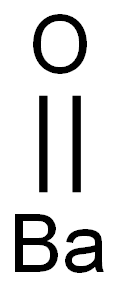-
外観
灰色〜うすい褐色又はうすい緑灰色, 粉末又は塊
-
性質
酸化バリウムの融点は1,920℃、沸点は2,000℃です。酸化バリウムと水が反応して水酸化バリウムが生成します。この反応は酸化カルシウムよりも激しく、発熱量も大きいです。
他の水溶性のバリウム化合物と同じく、水溶液には毒性があります。塩基性による腐食性も有しています。空気中や酸素中では加熱によって、酸化バリウムから過酸化バリウムを得ることが可能です。ただし、800℃以上の高温になると分解して、再び酸化バリウムに戻ります。
-
溶解性
水に難溶。希塩酸に溶け、水に極めて溶けにくい。
-
解説
酸化バリウム,白色の粉末.密度5.72 g cm-3.融点1923 ℃,沸点約2000 ℃.水に溶かすとはげしく反応して水酸化バリウムを生じる.酸と反応してバリウム塩を生じる.空気中に放置すると二酸化炭素を吸収して炭酸バリウムとなる.
森北出版「化学辞典(第2版)
-
製造
バリウムの硝酸塩,炭酸塩,過酸化物,水酸化物を強熱して得られる.
-
合成
酸素存在下で金属バリウムを燃焼すると、酸化バリウムが生成します。水酸化バリウムや炭酸バリウムなどの熱分解によっても、酸化バリウムを得ることが可能です。
ただし、この分解反応は、アルカリ土類金属の水酸化物や炭酸塩としては、最も高温を必要とします。具体的には、の分圧が1気圧のときの炭酸バリウムの分解温度は1,450℃、水蒸気圧が1気圧のときの水酸化バリウムの分解温度は998℃です。
-
応用
酸素と熱すれば過酸化バリウムとなる.脱水剤,乾燥剤,有機合成用触媒,炭酸ガス吸収剤,潤滑油添加剤,バリウム塩の製造,真空管やブラウン管の陰極材,ガラス工業などに用いられる.
-
使用上の注意
空気中で湿気及び二酸化炭素を吸収する。
-
物理的性質
Barium Oxide is
a white, hygroscopic formed by the burning of Ba metal
in oxygen or the decomposition of the carbonate salt:
2Ba+ O2→2BaO
BaCO3→BaO+ CO2
It transforms into the hydroxide on contact with
water.
BaO+H2O→Ba(OH)2
It is soluble in
ethanol, dilute acids and alkalis but insoluble in acetone
and liquid ammonia.
The monoxide is formed when the metal burns
in air, but is usually prepared by the ignition of the
nitrate, oxygen and oxides of nitrogen being liberated.
It can also be obtained by the ignition of an intimate
mixture of the carbonate and carbon, and in small quantities
by the ignition of the iodate.
-
使用
Barium oxide is used as a coating for “hot cathodes”
in a variety of electronic devices such as TV’s and lamps.
It replaced lead oxide in the production of certain kinds
of glass. While lead oxide raised the refractive index of
the glass, it also raised the dispersion, i.e refraction of
various colors of light resulting in distortion of images
which barium oxide does not alter. Barium oxide also
has use as an ethoxylation catalyst in the reaction of ethylene oxide and alcohols which takes place between
150 and 200°C.
The thermionic emission from thin evaporated films
of barium oxide has been studied extensively. Thin
barium oxide films have a good emission following
evaporation. The emission improves a little during
heat treatment, and is then similar to that from a sprayed
cathode coating of barium oxide.
-
定義
barium oxide: A white or yellowishsolid, BaO, obtained by heating bariumin oxygen or by the thermal decompositionof barium carbonate ornitrate; cubic; r.d. 5.72; m.p. 1923°C;b.p. 2000°C. When barium oxide isheated in oxygen the peroxide, BaO2,is formed in a reversible reactionthat was once used as a method forobtaining oxygen (the Brin process).Barium oxide is now used in themanufacture of lubricating-oil additives.
-
製造方法
Barium oxide is made by heating barium carbonate with coke, carbon black or tar:
BaCO3 + C→ BaO + 2CO
It may be also prepared by thermal decomposition of barium nitrate.
-
一般的な説明
A white to yellow powder. May be toxic by ingestion. Irritates skin, eyes and mucous membranes. Used as a drying agent for gasoline and solvents.
-
空気と水の反応
Hygroscopic. Reacts readily and exothermically with water to form a solution of corrosive barium hydroxide [Merck 11th ed. 1989].
-
反応プロフィール
BARIUM OXIDE reacts as a strong base. Combines exothermically with all categories of acids. Reacts with carbon dioxide to form barium carbonate [Merck 11th ed. 1989]. Ignites hydroxylamine on contact [Mellor 8:291 1946-47]. Mixtures with mercurous or nickel oxide react vigorously with hydrogen sulfide in air. Explosions may result [Mellor 10:140 1946-47]. Can react, particularly in the presence of moisture, with aluminum and zinc)to form oxides or hydroxides of the metal and generate gaseous hydrogen. May initiate polymerization reactions in polymerizable organic compounds, especially epoxides. May generate flammable and/or toxic gases with ammonium salts, nitrides, halogenated organics, peroxides, and hydroperoxides.
-
危険性
Toxic by ingestion. See barium.
-
健康ハザード
TOXIC; inhalation, ingestion or contact (skin, eyes) with vapors, dusts or substance may cause severe injury, burns or death. Reaction with water or moist air will release toxic, corrosive or flammable gases. Reaction with water may generate much heat that will increase the concentration of fumes in the air. Fire will produce irritating, corrosive and/or toxic gases. Runoff from fire control or dilution water may be corrosive and/or toxic and cause pollution.
-
火災危険
Non-combustible, substance itself does not burn but may decompose upon heating to produce corrosive and/or toxic fumes. Vapors may accumulate in confined areas (basement, tanks, hopper/tank cars etc.). Substance will react with water (some violently), releasing corrosive and/or toxic gases and runoff. Contact with metals may evolve flammable hydrogen gas. Containers may explode when heated or if contaminated with water.
-
使用用途
酸化バリウムは原料を代表として、バリウム塩 (・・など) やセラミックスの原料として利用されています。化学的安定性から塗料だけでなく、インキ・プラスチック・化粧品といった分野で活用されている硫酸バリウムの原料でもあります。硫酸バリウムは、X線検査の造影剤の一つです。
また、今日のIT分野で幅広く応用されているの原料としても知られています。さらに、合成化学において酸化バリウムは、塩基や乾燥剤として用いられています。
-
安全性プロファイル
A poison via
subcutaneous route. See also BARIUM
COMPOUNDS (soluble). Combustible by
spontaneous chemical reaction; produces
heat on contact with water or steam. Reacts
with H2O, Ba(OH)2. Incompatible with H2S,
hydroxylamine, N2O4, triuranium octaoxide,
so3.
-
職業ばく露
It is used to dry gases and solvents
and in producing detergents for lubricating oils.
-
輸送方法
UN1884 Barium oxide, Hazard Class: 6.1;
Labels: 6.1—Poisonous materials.
-
不和合性
Reacts with water, forming the strong
base, barium hydroxide. Keep away from acids, hydrogen
sulfide, carbon dioxide; hydroxylamine, nitrogen tetroxide;
sulfur trioxide; since violent reactions occur. Reacts with
triuranium. Never pour water into this chemical.
-
参考文献
W. Gerlach, Z. Physik, 9, 184 (1922), DOI: 10.1007/BF01326966.


